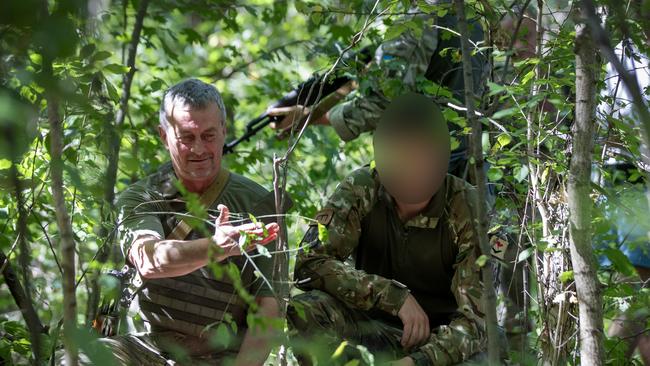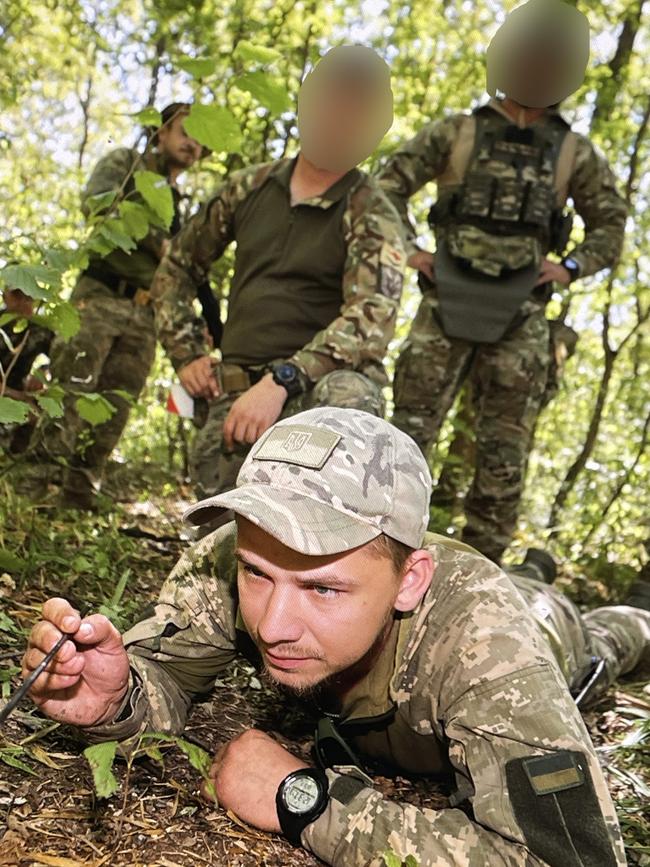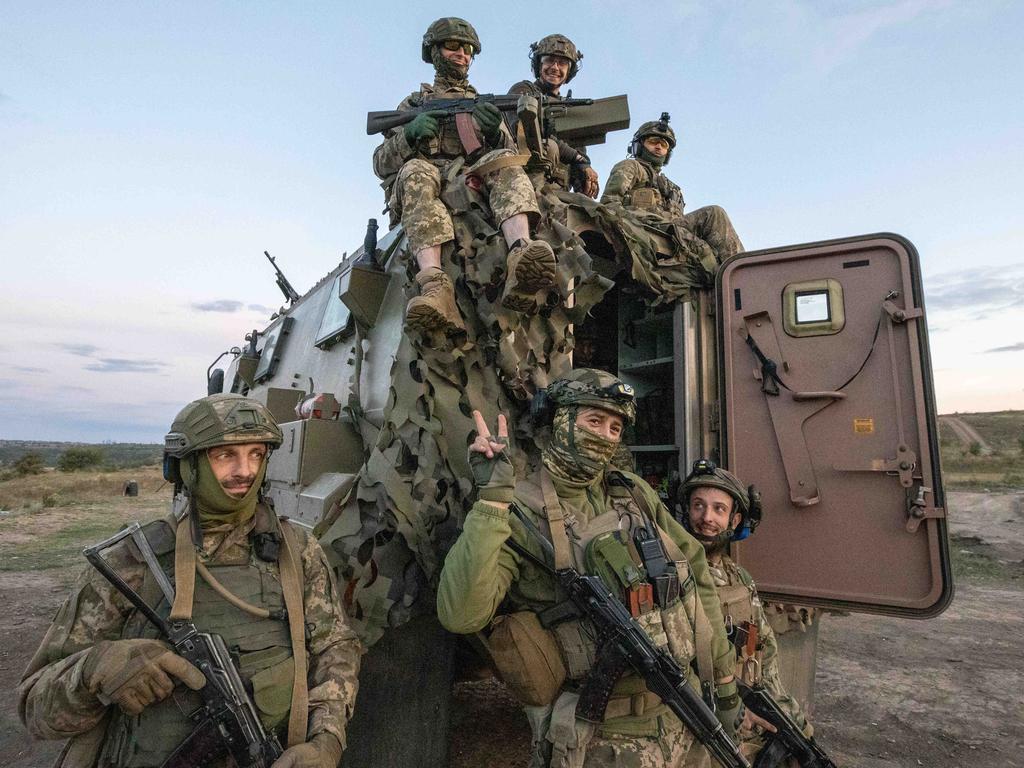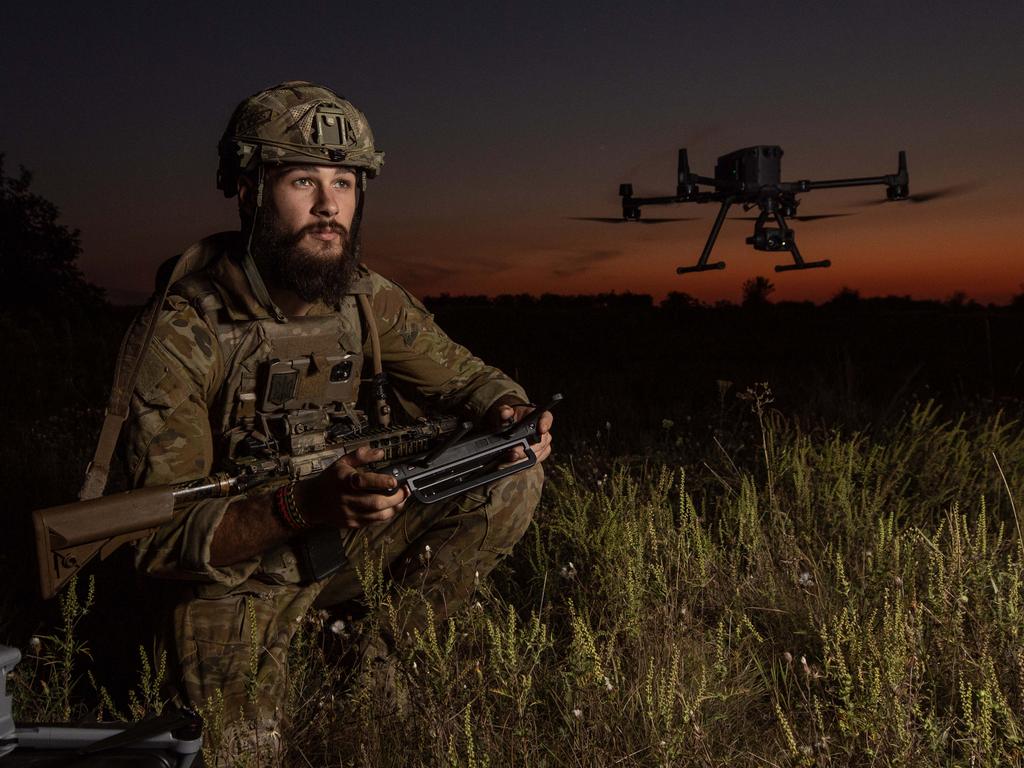I met the Aussies training soldiers in Ukraine how to de-mine battlefields
Under the watchful eye of their Australian teachers, scores of Ukrainians are put through a snap two-week training course before being sent to fight the Russian invaders.

Deep in dense shrubbery close to the frontline of Ukraine’s battle to fight off Russian forces, a small group of trainee soldiers searches for a makeshift explosive device – a grenade attached to a fishing line trip-wire – with a former Australian soldier closely watching on.
They are being taught the painstaking, meticulous and lifesaving process of disarming the thousands of booby-traps and landmines that are hidden in the battle-scarred landscape.
Under the watchful eye of their Australian teachers, scores of Ukrainians fighting for their survival are put through a snap two-week training course covering the “bare-bone basic” infantry skills, medical, de-mining and other training before being sent to the front line.
This might be an exercise but not long after their training these Ukrainians will be placed in life or death situations where with one wrong move it could all be over.
Just last week, former Australian soldier Nick Parsons and a British colleague were killed in another part of eastern Ukraine, about two hours from the training facility, while clearing mines for an explosives-disposal charity.
Parsons was one of hundreds of Australians who have flown to Ukraine either to fight or lend their expertise in training Ukrainian soldiers, or both, since Russia’s invasion in February 2022.

This band of Aussies have already built a tight camaraderie with the Ukrainians, even exchanging music recommendations, with locals becoming familiar with Australian bands such as Tame Impala, Men at Work, and Ocean Alley.
The work they do is also literally saving local lives. Ukraine is now the most mined country in the world, with experts predicting it will take decades to remove unexploded ordnance, and as the war continues to drag on locals are relying on Australian volunteers to teach them how to de-mine fields of Russian ordnance and booby traps – some so crude they use vapes as detonators.
In this case of a hidden grenade attached to a trip-wire, the former Australian soldier is adamant it will be discovered by the search team he has trained and is just about to graduate – if they pass this final exercise.
“They’ll find that very easily,” he says. “It is pretty hard to see with your eyes.
“We get them to use a search stick, so as long as you’re walking along and doing your drills correctly you’ll come along and hit it with the stick,” one of the Australian soldiers said.
Other booby traps, however, can be designed to be set off by the search stick if the grenade is secured with a paperclip.
“They can use safety pins, and then it makes the grenade much more sensitive, so even just a little wiggle can set it off … most of the trip-wires in a forest will be set off by animals,” he said.
The Australians explain how Russian-planted booby-traps are actually tasked with injuring – and not killing – soldiers in order to take up valuable battlefield resources for a casualty evacuation.
Another Australian soldier, from the Gold Coast, explained how Russian soldiers were heavily relying on improvised explosive devices, especially in urban areas.
“When they withdraw from buildings they’ve occupied, they often leave behind numerous IEDs,” the soldier said. “These devices are deliberately placed to target civilians, children, and anyone conducting searches.
“It’s been done for decades, but on this scale it hasn’t been seen for a long, long time.”
The Australian soldiers also teach the Ukrainians how to check to see if a vehicle mine has been booby-trapped to detonate when a soldier tries to disarm it.
The goal again is not necessarily death and destruction – there are other advantages to be gained in a war zone. Disarming and checking three vehicle mines could delay a team by more than an hour and put them in danger of an ambush. Similarly, de-mining an open field can take hours and hours, potentially slowing down forces to sometimes not even advancing a kilometre a day.
“They could be fake, but it is an incredibly slow and tedious process but you have to do it otherwise someone could die because you were lazy,” says one Aussie.
There’s a heightened paranoia that the secret location of the training facility just outside of Kharkiv city, in northeast Ukraine, will be targeted by the Russians.
The city is often the subject of drone and missile strikes but the frequency of attacks has reduced since the US permitted Ukraine to strike certain Russian targets at the end of 2024.
The target of those strikes is often energy infrastructure, but the training school could become the target of a Russian missile or drone strike, such is the secrecy surrounding the location of the top-secret compound where soldiers train for several weeks.
The obvious dangers have still not deterred the Australians from their mission.
As one Ukrainian said: “The one fact that really pleasantly surprised me about our Australian instructors was that they’re doing their fair share to adapt to our society, they try to be a functional part of it.
“For me it’s a great sign of professionalism.”






To join the conversation, please log in. Don't have an account? Register
Join the conversation, you are commenting as Logout